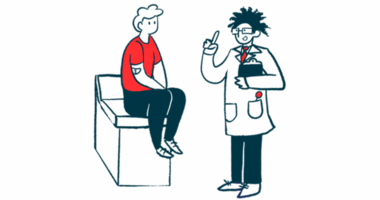Occupational therapy for myasthenia gravis
Last updated Dec. 18, 2024, by Agata Boxe

Symptoms of myasthenia gravis (MG) can interfere with daily tasks, but for people with the rare neuromuscular disease, MG occupational therapy may help to improve mobility and maintain independence.
MG often causes muscle weakness and fatigue, which can make it challenging to do everyday activities such as getting dressed, cooking, or even holding a pen.
If you have MG, an occupational therapist can guide you with daily modifications and adaptations to your home so you can live a full life. They may also work with your healthcare team and caregivers to support your overall well-being.
Understanding occupational therapy
Living with MG often means you may be dealing with fatigue, muscle weakness, and mobility problems, which can affect your ability to care for yourself and take part in work and leisure activities. While MG is more commonly diagnosed in adults, the disease may also develop in adolescents and children.
An occupational therapist can help you remain independent by finding new ways to manage your daily life. They can make recommendations that are tailored to your life stage and how you spend your time. They also consider the effect that health conditions may have on your quality of life and recommend possible ways to address it.
In collaboration with your MG healthcare team, an occupational therapist can:
- offer recommendations for making your home safer and a more accessible and comfortable living space
- ensure that your workspace, whether at school or in the office, is tailored to your needs
- suggest exercises for leg and arm weakness, such as those involving elastic bands to strengthen hands and fingers
- teach you energy-conservation strategies, for example, purchasing pre-chopped foods for cooking or sitting when folding laundry
- help you find the best adaptive equipment, such as shower seats and grip aids
- recommend self-care activities, which may include meditation and breathing techniques to manage stress, a common MG flare-up trigger
- identify strategies that address insomnia, which can worsen MG fatigue.

Being assessed
An occupational therapist will first assess your ability to move around and complete daily tasks such as putting on a shirt, brushing your teeth, or making a cup of coffee. The evaluation is not something to prepare for or worry about. It is a proactive tool for the occupational therapist so they can create a MG occupational therapy treatment plan based on your specific needs.
The therapist will ask about your medical history, symptoms, and treatment, as well as review your medical records. They may ask whether there are certain activities you used to enjoy that are now challenging.
They will then do a functional assessment, evaluating your ability to:
- move around, including walking, sitting down, getting up, and using mobility aids, if needed
- manage daily activities such as grooming and getting dressed
- use hands and fingers, for writing, buttoning clothes, and holding utensils for eating.
They will ask how you interact with your home, work, or school environment, and offer to visit those places to help adjust the environment to your needs. For example, they may help you set up an ergonomic workstation and check whether your desk chair needs adjustment, such as arm supports to prevent muscle fatigue.
To prepare for your first appointment, consider:
- your daily routine
- specific tasks that you may find challenging
- what your goals are for occupational therapy
- any questions you may have for the therapist.
Be sure to bring your medical records and any mobility aids you may use.
Benefits of occupational therapy for people with MG
Occupational therapy benefits include more independence, improved mobility, making environments such as your home safer, and a greater ability to complete everyday tasks and participate in hobbies.
In addition to helping with daily activities, such as eating, preparing meals, and hygiene, occupational therapists can provide and introduce new assistive technologies and equipment. With their assistance, you can learn how to plan out your days in a way that improves your physical and mental health.
An occupational therapist can help you:
- develop a realistic daily schedule that incorporates breaks and allows you to maintain your energy throughout the day
- determine which tasks, such as cleaning or cooking, you can ask others to assist you with, to conserve your energy
- adjust your body posture to address muscle weakness, especially for work or school
- find the right tools to do daily tasks more easily, such as magnetic buttons and closures for getting dressed, shoehorns for putting on shoes, and light utensils for eating
- learn to use switch-activated devices, from toys to home appliances, and speech-to-text technologies if you need them
- adapt your home to your needs by installing shower grab bars in the bathroom and arranging the heaviest appliances in the kitchen within arm’s reach.
An occupational therapist may also ask you to log your activities and mood for one or more days, noting what makes you feel well and what doesn’t. Based on this information, you can discover which days you enjoyed more than others. You can then try to recreate them in the future by adding the activities that boost your well-being while limiting those that negatively impact it.
Your occupational therapist can also identify equipment and strategies that allow you to continue doing your hobbies. For example, you could purchase ergonomic tools for gardening, or plant in small, light pots placed on a table while sitting instead of putting plants in the ground.
Is occupational therapy the same as physiotherapy?
Occupational therapy generally differs from physical therapy (also called physiotherapy), although the two share some similarities.
Physical therapy focuses on general body movement involving the larger muscle groups such as the core, hips, back, shoulders, and legs. It encompasses walking, balancing, getting in and out of a chair, as well as strength and endurance.
Occupational therapy addresses body movements required for daily living activities. Examples include buttoning a shirt, brushing your hair, writing, and preparing meals. An occupational therapist will teach you how to modify activities and the movements they involve to make them easier to do.
Occupational and physical therapy are similar in some ways. They both involve:
- assessing your mobility with the aim to improve it
- helping you manage fatigue and weakness, either through muscle-strengthening exercises or energy-conserving techniques
- training you in the use of mobility aids, such as wheelchairs, walkers, and rollators.
Collaborating with other healthcare teams
An MG diagnosis often involves a variety of symptoms, from fatigue to swallowing problems and slurred speech, which is why a multidisciplinary care approach is needed.
Occupational therapists may work closely with others on your healthcare team, such as your neurologist, physical therapist, speech therapist, and dietitian. They may collaborate with a dietician and a physical therapist to develop a diet and exercise plan supported by an accessible kitchen and gym setup. They may be in touch with other healthcare professionals to ensure a well-rounded MG treatment plan is set in place.
Occupational therapists can also educate caregivers on ways to support you in minimizing overexertion and fostering independence by:
- teaching them how to help you get in and out of bed
- training them to assist you in getting dressed and with bathing
- providing advice on how and when to offer help
- sharing active listening and other communication techniques so they can better understand your needs
- connecting you with support groups for people with MG.
Myasthenia Gravis News is strictly a news and information website about the disease. It does not provide medical advice, diagnosis, or treatment. This content is not intended to be a substitute for professional medical advice, diagnosis or treatment. Always seek the advice of your physician or other qualified health provider with any questions you may have regarding a medical condition. Never disregard professional medical advice or delay in seeking it because of something you have read on this website.
Recent Posts
- FDA approves inebilizumab, now Uplizna, to treat adults with gMG
- Getting a generalized MG diagnosis can take more than 2 years: Study
- Reexamining doctor-patient relationships with more compassion
- Foundation creates digital guide to decode medical jargon in MG
- Thoughtful gift ideas for someone with myasthenia gravis
Related articles





